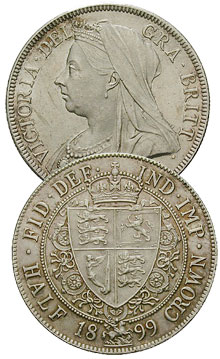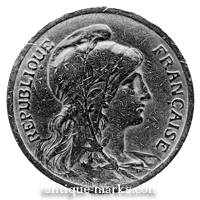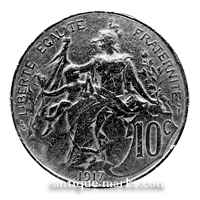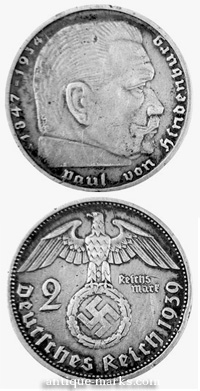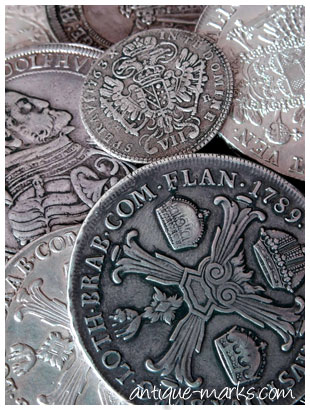Economic uncertainty means many collectors & investors are turning to pure silver bullion to protect their wealth. Old European silver coins present an interesting and varied alternative to the usual silver dollars and ioz silver bars and of course they help us avoid melting down our beautiful collectable antique silver teasets and candelabra
Contents
Investing in Collectable European Silver Coins
Many investors are now turning to pure silver bullion to protect their wealth, but old European silver coins present an interesting and varied alternative.
European mints have been producing silver coinage for centuries.
This article discusses the silver coinage of five major European producers, the history behind European coinage, and practical advice for the investor or collector who is looking to collect old silver European currency.
It follows on from our article on How to Collect Junk Silver Coins.
Which are usually bought and sold as a cost effective way to invest in silver; an excellent way to hedge against inflation and protect yourself in times of financial crisis.
Silver has long been a trusted and reliable store of wealth and means of exchange.
For the laborer or craftsman living and working hundreds of years ago, a piece of silver might have been good compensation for a day's work.
And unlike its fellow precious metals; gold and platinum, silver is quite affordable for the average consumer. Today, many are turning to silver to protect their wealth in the face of doubts about the strength of the world economy and the stability of national and regional currencies.
Physical 99.9 percent fine silver is a popular and effective way to collect and store wealth, as are silver ETFs. There are, however, other ways to collect silver.
Mints around the world have been producing silver coinage for hundreds of years, and European Silver Coins come from the oldest of these mints.
European Coins in this Section:
Countries such as Austria, France, Great Britain and Germany have had a long and storied history of silver coinage production. If you have an interest in history and would like to diversify your stock of precious metals, there are few better ways to do so than with well-known and well-trusted old European silver coins.
Before buying any silver coin, however, you should first know exactly what it is you're buying.
Different European countries have minted silver coins at different times, in different quantities, and using different purities, and it is vital to know just what it is you're buying to ensure that you get the best price. Also keep in mind that, with one exception, all of the currencies mentioned below have been demonetized in favor of the Euro: while they still have historical and precious metal value, they are no longer circulated.
Collectors of European silver coins may be familiar with the beautiful Wiener Philharmoniker silver bullion coins, which the Austrian government mints to this day.

Like France, Austria began minting all of her silver coinage at .900 purity and later reduced it to .835.
The most commonly available Austrian silver coins with some numismatic value are the 83.5% pure silver coronas of the Austro-Hungarian Empire.
These coins were minted from 1892 to 1918, when the Central Powers lost the war and the empire was broken into several pieces by the victorious Alies.
However, the best-known Austrian silver coin is the Maria Theresa thaler.
This large, beautiful silver coin has a purity of .835 and bears the profile of Empress Maria Theresa of Austria on the obverse and the imperial Austrian double-headed eagle on the reverse. It has been minted for nearly three hundred years and has been used throughout the world as a medium of trade.
Since 1780, every silver Austrian thaler has kept the date 1780, regardless of its actual year of mintage. It has also undergone no design changes, meaning that a silver thaler minted in 2010 looks identical to one minted in 1810. This fascinating coin is well worth owning for this fact alone.
Like France, Britain has been minting silver coins for centuries. Unlike France, however, Britain has not suffered through nine major regime changes in the past two hundred years.

And just as France's tumultuous political history is reflected in its constantly changing coinage, Britain's political continuity is reflected in its consistent coinage.
For several centuries, the coins of England and later Great Britain have featured the portrait of its monarch on the obverse.
There are two important things to remember, however, when buying British silver coins.
The first is the exact year of the pound sterling's debasements. Until 1919, all British coinage from the threepence up was made out of .925 silver, a purity known as sterling silver.
- In 1920, the British government decided to reduce its currency's silver purity to .500, or 50%, silver.
- Britain took this step for the same reason that France rid her currency of all silver content in the same year: she needed the silver to pay war debts accumulated during World War I.
- Finally, in 1947, the British pound sterling was completely rid of its silver content.
The second point to remember about Great Britain is that all of her silver coinage was minted before the pound sterling was decimalized in 1971. This can make it slightly more difficult to determine the relative worth of various coins.
-
- Just remember that there are two threepence in a sixpence, two sixpence in a shilling, two shillings in a florin, and ten florins (or twenty shillings) in a pound.
- The half-crown is worth two and a half shillings, and the crown is worth five shillings, or a quarter of a pound.
- If you keep these relationships in mind, you should be able to easily navigate this obsolete and sometimes confusing denominational system.
If you are looking for high purity European silver coins, concentrate on British coinage from the late 19th century up to World War I.
These coins tend not to be too expensive, although it can be hard to find coins that are not worn. You are most likely to find sterling British coinage minted in the early part of King George V's reign, just before the debasement to 50% purity.
Later British silver coins from the 1920's through the end of World War II are easier to find, but their lower purity may make them unattractive to the European silver coins investor. Nevertheless, they are well worth collecting for their historical value.
As one of the oldest states in Europe, France has had a long and proud history of producing European silver coins.
From the days of the Ancien Régime up to the 1960s, the French have minted beautiful silver coins in various sizes, denominations, and purities.
That long history is also a complicated one.
Since the French Revolution, when the old livre was replaced by the new franc, both the people of France and their currency have endured ever more revolution, counter-revolution, and war after war.
A country's history can often be traced by the changes in its currency and this is very true in the case of France
Silver francs from the Revolution onwards bear the faces of ...
- Emperor Napoleon I
- The restored Bourbon King Louis XVIII, his brother and successor Charles X
- Charles' overthrower King Louis-Phillipe
- the Greek mythological figures Ceres and Hercules representing the short-lived Second Republic
- Emperor Napoleon III
- and finally the figure of Lady Liberty in 1870 with the creation of the Third Republic
A history lover can hardly ask for more historical value and variety in a currency. However, this amount of variety also complicates matters for those investing in European silver coins.
Until the 1860s, French francs were minted in .900 pure silver (meaning an alloy of 90% silver and 10% base metal, typically copper or bronze), after which they were debased to a .835, or 83.5%, purity.
This purity lasted until 1920, when the French government was forced to mint francs in base metals as a result of the high levels of spending and the runaway inflation caused by its involvement in World War I. France only returned to minting silver coinage in the 60s and 70s, and then only briefly.
If you are looking for a good price relative to the spot price of silver, your best bets are France's turn of the century silver francs and its 60s and 70s silver coinage.
- Some of the most commonly available and affordable are the 50 centime, 1 franc and 2 franc denominations of the 1898-1920 design of the mid-period Third Republic.
- .835 pure silver 5 franc coins minted from 1959 to 1969 are also widely available,
- As are .900 pure silver 10 franc and 50 franc coins minted from 1964 to 1973 and from 1974 to 1980 respectively.
Older French silver from the mid-19th century and before is also fairly easy to find, but it tends to be very expensive, very worn, or both.
A well-preserved silver franc from the time of Napoleon I. might easily cost five hundred dollars or more. These coins are beautiful and well worth buying for the hardcore collector, but they will almost always be priced out of range for the European silvers coins investor.
Germany probably has one of the most interesting and varied catalogues of coinage of any country in the world.
Pre-unification Germany consisted of hundreds of kingdoms, duchies, principalities, and independent cites, each with its own ruler, laws, and currency.
From the 15th and 16th centuries up until World War I, German states such as Prussia, Bavaria, Württemburg, Baden, Saxony, and Hesse minted their own coins, usually bearing the portraits of their respective rulers.
Even after all of these various entities had been joined together by Otto von Bismarck to form the German Empire in the 1870s, they continued to mint their own 2, 3, and 5 mark coins.
Late 19th century silver coins minted by the German states are fairly easy to find and quite affordable, considering their age.
The easiest silver imperial German coins to find are probably the standardized half and 1 mark coins minted from 1875 to 1919 and 1916 respectively, but the larger 2, 3, and 5 mark coins are also well worth owning for their historical value and high silver purity.
Following German coinage up through 1918 is easy. Almost all of the coins the German states and the Empire produced were minted in .900 pure silver, and they were minted continuously through the various stages of German unification.
After 1918, things get a bit more complicated for the collector of German European silver coins.
World War I ended in disaster for Germany: her land mass was reduced by twenty percent, she lost the use of the rich coal fields of the Rhineland to France, and her military was cut down to a token force.
The most crushing stipulations of the 1919 Treaty of Versailles, however, had to do with war reparations. Germany was forced to pay enormous sums of money to the victorious Allies as a condition of her surrender. This depleted the German treasury and drove the new republican government to print massive amounts of paper money, leading to one of the worst cases of inflation in history.
As a result of these financial burdens, many old silver marks were melted and sent abroad to pay Germany's debts, and Germany stopped minting silver marks until the mid-1920s, when the republican Weimar government began issuing 50% pure silver 1 and 2 Reichsmark coins.
If there are any European silver coins that investors might be wary of buying, they were probably minted by 1930s-period Germany.
Adolf Hitler's Third Reich minted silver 2 and 5 Reichsmark coins from 1933 to 1939 with purities of .625 and .900 respectively. For the first few years, the Nazi government refrained from inserting the swastika into its coins' designs - it's possible that the new regime did not yet feel secure enough to deface the traditional German eagle with its own symbol.
Starting in 1936, however, all German coins were redesigned to feature the Nazis' stylized eagle carrying a wreathed swastika, including the silver 2 and 5 mark denominations. The obverse of these Nazi-produced coins bear the image of former German president Paul von Hindenburg, an old German World War I hero and a distinctly non-Nazi figure.
These coins are readily available and sought after by World War II memorabilia collectors, but some people may not want to own coins bearing the swastika. If you are one such collector, don't worry: the great majority of German European silver coins were not minted by the Nazis, so these particular coins can be easily passed over when putting together your collection.
The story doesn't end there, however. After the end of World War II and Germany's subsequent occupation and division by the Allies, the Federal Republic of Germany (better known as West Germany) began minting silver coins once again.
From 1951 to 1974, West German 5 mark coins were composed of .625 pure silver; after 1974, they were switched over to a copper-nickel format. These silver 5 mark coins had a high mintage and all bear the German eagle on the obverse and a circular inscription on the reverse with a large "5" in the middle.
Germany has since produced several 5 and 10 mark commemorative silver coins, all with the same .625 purity.
Unlike the countries mentioned above, Switzerland still uses the same currency system she was using over a century ago.
The Swiss franc is one of the strongest and most trusted currencies in the world, and up until 1967, all of her coinage from the half franc denomination up was minted in silver with a purity of .835
In fact, Switzerland's European silver coins are the most consistently produced in all of Europe, a fact having mostly to do with the longstanding Swiss tradition of neutrality.
Without having to deal with the disruptions of war, the Swiss were able to continue minting silver coinage when France, Germany, and nearly every other country in Europe was forced to switch to base metals such as zinc and aluminum.
As with every other country on this list, Switzerland has had a long history of silver coinage production,
- The most common and affordable of its silver coins are the half franc, 1 franc, and 2 franc coins, minted continuously from 1874 to 1967.
- Switzerland also minted silver 5 franc coins with a .835 purity from 1931 to 1969, and variously with purities of .835 and .900 before 1931.
The silver Swiss franc represents one of the best hedges on the market today
It has numismatic value (depending on the quality and date of the coin), it has precious metal value, and it is still an actively used and circulated currency.
There are few better options available to the prospective investor than collecting Swiss European silver coins.
So, Are European Silver Coins a Good Investment?
The five countries above produce the European silver coins most likely to be found in the United States or other parts of the world, but they are far from the only ones.
Almost every country in Europe has issued silver coinage, whether as circulating money or as commemorative pieces.
The silver coins investor just has to make sure they know what they are buying in order to safely accumulate enough European silver coins as a hedge against economic or monetary collapse.


